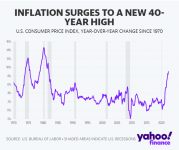Trump's failed trade policy was tne real killer to the economy and igniter of high inflation
Read on
Section 301 tariffs on China currently remain in place under the Biden administration and account for $71 billion of the $75 billion in tariff revenues, based on 2018 import values.
WTO Dispute, European Union
In October 2019, the United States won a nearly 15-year-long World Trade Organization (WTO) dispute against the European Union. The WTO ruling authorizes the United States to impose tariffs of up to 100 percent on $7.5 billion worth of EU goods. Beginning October 18, tariffs of 10 percent were to be applied to aircrafts and 25 percent on agricultural and other products (our estimate uses the average of the two rates).
Tariffs on the European Union were suspended in summer 2021 for five years under an agreement reached by the Biden administration.
Section 201, Solar Panels and Washing Machines
In January 2018, the Trump administration announced it would begin imposing tariffs on washing machine and solar cell and module imports as the result of a Section 201 investigation.
We estimated the solar cell and module tariffs amount to a $0.2 billion tax increase based on 2018 import values and quantities of four 8-digit Harmonized Tariff Schedule subheadings, given on page 12 of this report. The United States imported 6.8 billion watts worth a value of $4.9 billion in 2018 under the four subheadings. The Biden administration extended the solar panel tariffs at a rate of 14.75 percent on imports above a 5 gigawatt exemption.
We estimated the washing machine tariffs amount to a $0.4 billion tax increase based on 2018 import values and quantities of six 8-digit Harmonized Tariff Schedule subheadings, given on page 8 of this report. The United States imported $1.3 billion worth of machines and $114 million worth of parts in 2018. For most of 2022, a tariff of 14 percent applies to in-quota washing machines and parts and a tariff of 30 percent applies to all subsequent washing machines and parts.
Tariffs on solar panels and washing machines currently remain in place under the Biden administration and account for $0.6 billion of the $75 billion in tariffs revenues, based on 2018 import values.
Model Results
According to the Tax Foundation model, the tariffs imposed under the Trump administration and left in place under the Biden administration would reduce long-run GDP by 0.22 percent ($56.7 billion) and wages by 0.14 percent and eliminate 173,000 full-time equivalent jobs.
Table 1: Impact of Remaining Trump Administration Tariffs TotalSection 232 – Steel and AluminumSection 301 – China (25% on 34, 16, 200; 7.5% on 112)Solar Panels and Washing MachinesTariff Revenue$74.7$2.9$71.2$0.6Long-run GDP-0.22%-0.01%-0.21%0.00%GDP ($2018)-$55.7-$3.6-$51.7-$0.4Wages-0.14%-0.01%-0.13%0.00%FTE Jobs-173,000-11,000-160,000-1,000
Note: Totals may not add due to rounding.
Source: Tax Foundation Taxes and Growth Model, March 2018.
The 0.22 percent reduction in long-run GDP is about 13.5 percent of the total long-run impact of the Tax Cuts and Jobs Act, which we estimated to raise GDP by 1.7 percent in the long run.
Trade Volumes Since Tariffs Were Imposed
Since the tariffs were imposed, imports of affected goods have fallen, even before the onset of the COVID-19 pandemic. Some of the biggest drops are the result of decreased trade with China, as affected imports decreased significantly after the tariffs. Reduced trade means fewer options for U.S. consumers and higher prices.
Table 2. Import Volumes of Goods Affected by TariffsTariff and Effective Date2017 imports, billions 2018 imports, billions 2019 imports, billions 2020 imports, billions 2021 imports, billions Tariff RateSection 232 Steel (March 2018)$15.9$15.5$11.4$7.2$13.725%Section 232 Aluminum (March 2018)$9.0$9.6$8.4$5.2$7.610%Section 232 Derivative Steel Articles (February 2020)$0.4$0.5$0.5$0.4$0.425%Section 232 Derivative Aluminum Articles (February 2020)$0.2$0.3$0.2$0.2$0.310%Section 301, List 1 (July 2018)$31.9$30.3$22.7$20.9$24.725%Section 301, List 2 (August 2018)$13.8$14.8$8.6$9.8$10.425%Section 301, List 3 (September 2018; increased May 2019)$187.6$206.1$126.9$112.8$126.425%Section 301, List 4A (September 2019; lowered January 2020)$101.9$112.2$114.7$103.2$105.315% in 2019; then 7.5%Section 301, List 4B (Never went into effect)$151.2$160.0$159.6$164.4$206.3Suspended
Note: Steel totals exclude imports from Argentina, Australia, Brazil, South Korea, Canada, and Mexico. Aluminum totals exclude imports from Argentina, Australia, Canada, and Mexico. Beginning in 2022, steel and aluminum imports from the EU and UK will be subject to tariff-rate quotas as well as steel imports from Japan. TRQs will be reflected in the table when 2022 import volumes become available in 2023.
Source: Federal Register notices; Tom Lee and Jacqueline Varas, “The Total Cost of U.S. Tariffs,” American Action Forum, Mar. 24, 2022,
https://www.americanactionforum.org/research/the-total-cost-of-tariffs/; data retrieved from USITC DataWeb; author calculations.
Retaliatory Tariffs Imposed and Threatened
Several jurisdictions have proposed and imposed retaliatory tariffs against the United States as laid out in the accompanying tables.
Current retaliation against Section 232 steel and aluminum tariffs target more than $6 billion worth of American products for an estimated total tax of approximately $1.6 billion. Tariff revenues for Turkey, India, Russia, and Canada were based on news reports. Mexico, Canada, and the European Union have canceled their Section 232 retaliatory tariffs.
Table 3. Section 232 Steel and Aluminum RetaliationJurisdictionU.S. Exports (billions, 2018)Tariff RateEstimated Levy (billions)Russia$0.425-40%$0.1
Note: Mexico, Canada, and the European Union canceled their Section 232 retaliatory tariffs.
Source: Congressional Research Service, “Escalating U.S. Tariffs: Affected Trade,” last updated Jan. 29, 2020,
https://fas.org/sgp/crs/row/IN10971.pdf ; author calculations; tariff announcements.
China has responded to the United States’ Section 301 tariffs with several rounds of tariffs on more than $106 billion worth of U.S. goods, for an estimated tax of nearly $11.6 billion.
Table 5: Impact of Retaliatory Tariffs TotalSection 232 RetaliationSection 301 RetaliationTariff Revenue (billions of 2018 dollars)$0$0$0Long-run GDP-0.04%0.00%-0.03%GDP (billions of 2018 dollars)-$9.4-$1.1-$8.3Wages-0.02%0.00%-0.02%FTE Jobs-29,000-4,000-26,000
Note: Totals may not add due to rounding. Tariff revenue is $0 because retaliatory tariffs are not paid to the U.S. government.


 www.cnn.com
www.cnn.com

 www.wsj.com
www.wsj.com

 www.cnbc.com
www.cnbc.com





